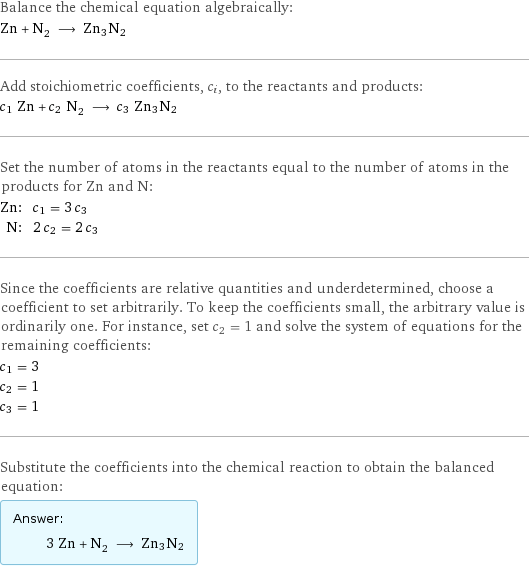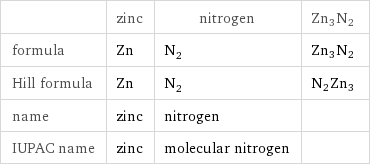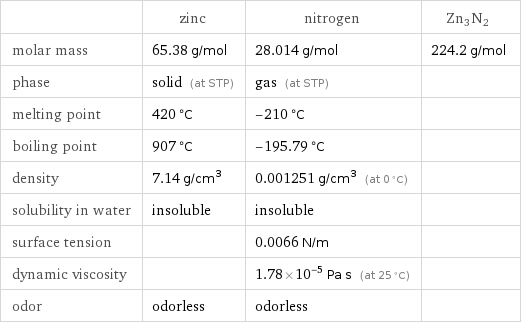Input interpretation

Zn zinc + N_2 nitrogen ⟶ Zn3N2
Balanced equation

Balance the chemical equation algebraically: Zn + N_2 ⟶ Zn3N2 Add stoichiometric coefficients, c_i, to the reactants and products: c_1 Zn + c_2 N_2 ⟶ c_3 Zn3N2 Set the number of atoms in the reactants equal to the number of atoms in the products for Zn and N: Zn: | c_1 = 3 c_3 N: | 2 c_2 = 2 c_3 Since the coefficients are relative quantities and underdetermined, choose a coefficient to set arbitrarily. To keep the coefficients small, the arbitrary value is ordinarily one. For instance, set c_2 = 1 and solve the system of equations for the remaining coefficients: c_1 = 3 c_2 = 1 c_3 = 1 Substitute the coefficients into the chemical reaction to obtain the balanced equation: Answer: | | 3 Zn + N_2 ⟶ Zn3N2
Structures

+ ⟶ Zn3N2
Names

zinc + nitrogen ⟶ Zn3N2
Equilibrium constant
![Construct the equilibrium constant, K, expression for: Zn + N_2 ⟶ Zn3N2 Plan: • Balance the chemical equation. • Determine the stoichiometric numbers. • Assemble the activity expression for each chemical species. • Use the activity expressions to build the equilibrium constant expression. Write the balanced chemical equation: 3 Zn + N_2 ⟶ Zn3N2 Assign stoichiometric numbers, ν_i, using the stoichiometric coefficients, c_i, from the balanced chemical equation in the following manner: ν_i = -c_i for reactants and ν_i = c_i for products: chemical species | c_i | ν_i Zn | 3 | -3 N_2 | 1 | -1 Zn3N2 | 1 | 1 Assemble the activity expressions accounting for the state of matter and ν_i: chemical species | c_i | ν_i | activity expression Zn | 3 | -3 | ([Zn])^(-3) N_2 | 1 | -1 | ([N2])^(-1) Zn3N2 | 1 | 1 | [Zn3N2] The equilibrium constant symbol in the concentration basis is: K_c Mulitply the activity expressions to arrive at the K_c expression: Answer: | | K_c = ([Zn])^(-3) ([N2])^(-1) [Zn3N2] = ([Zn3N2])/(([Zn])^3 [N2])](../image_source/8a8c81b48a51a6574fc726badb50e66a.png)
Construct the equilibrium constant, K, expression for: Zn + N_2 ⟶ Zn3N2 Plan: • Balance the chemical equation. • Determine the stoichiometric numbers. • Assemble the activity expression for each chemical species. • Use the activity expressions to build the equilibrium constant expression. Write the balanced chemical equation: 3 Zn + N_2 ⟶ Zn3N2 Assign stoichiometric numbers, ν_i, using the stoichiometric coefficients, c_i, from the balanced chemical equation in the following manner: ν_i = -c_i for reactants and ν_i = c_i for products: chemical species | c_i | ν_i Zn | 3 | -3 N_2 | 1 | -1 Zn3N2 | 1 | 1 Assemble the activity expressions accounting for the state of matter and ν_i: chemical species | c_i | ν_i | activity expression Zn | 3 | -3 | ([Zn])^(-3) N_2 | 1 | -1 | ([N2])^(-1) Zn3N2 | 1 | 1 | [Zn3N2] The equilibrium constant symbol in the concentration basis is: K_c Mulitply the activity expressions to arrive at the K_c expression: Answer: | | K_c = ([Zn])^(-3) ([N2])^(-1) [Zn3N2] = ([Zn3N2])/(([Zn])^3 [N2])
Rate of reaction
![Construct the rate of reaction expression for: Zn + N_2 ⟶ Zn3N2 Plan: • Balance the chemical equation. • Determine the stoichiometric numbers. • Assemble the rate term for each chemical species. • Write the rate of reaction expression. Write the balanced chemical equation: 3 Zn + N_2 ⟶ Zn3N2 Assign stoichiometric numbers, ν_i, using the stoichiometric coefficients, c_i, from the balanced chemical equation in the following manner: ν_i = -c_i for reactants and ν_i = c_i for products: chemical species | c_i | ν_i Zn | 3 | -3 N_2 | 1 | -1 Zn3N2 | 1 | 1 The rate term for each chemical species, B_i, is 1/ν_i(Δ[B_i])/(Δt) where [B_i] is the amount concentration and t is time: chemical species | c_i | ν_i | rate term Zn | 3 | -3 | -1/3 (Δ[Zn])/(Δt) N_2 | 1 | -1 | -(Δ[N2])/(Δt) Zn3N2 | 1 | 1 | (Δ[Zn3N2])/(Δt) (for infinitesimal rate of change, replace Δ with d) Set the rate terms equal to each other to arrive at the rate expression: Answer: | | rate = -1/3 (Δ[Zn])/(Δt) = -(Δ[N2])/(Δt) = (Δ[Zn3N2])/(Δt) (assuming constant volume and no accumulation of intermediates or side products)](../image_source/e14e3953f1ee50e601fe2bde5f881603.png)
Construct the rate of reaction expression for: Zn + N_2 ⟶ Zn3N2 Plan: • Balance the chemical equation. • Determine the stoichiometric numbers. • Assemble the rate term for each chemical species. • Write the rate of reaction expression. Write the balanced chemical equation: 3 Zn + N_2 ⟶ Zn3N2 Assign stoichiometric numbers, ν_i, using the stoichiometric coefficients, c_i, from the balanced chemical equation in the following manner: ν_i = -c_i for reactants and ν_i = c_i for products: chemical species | c_i | ν_i Zn | 3 | -3 N_2 | 1 | -1 Zn3N2 | 1 | 1 The rate term for each chemical species, B_i, is 1/ν_i(Δ[B_i])/(Δt) where [B_i] is the amount concentration and t is time: chemical species | c_i | ν_i | rate term Zn | 3 | -3 | -1/3 (Δ[Zn])/(Δt) N_2 | 1 | -1 | -(Δ[N2])/(Δt) Zn3N2 | 1 | 1 | (Δ[Zn3N2])/(Δt) (for infinitesimal rate of change, replace Δ with d) Set the rate terms equal to each other to arrive at the rate expression: Answer: | | rate = -1/3 (Δ[Zn])/(Δt) = -(Δ[N2])/(Δt) = (Δ[Zn3N2])/(Δt) (assuming constant volume and no accumulation of intermediates or side products)
Chemical names and formulas

| zinc | nitrogen | Zn3N2 formula | Zn | N_2 | Zn3N2 Hill formula | Zn | N_2 | N2Zn3 name | zinc | nitrogen | IUPAC name | zinc | molecular nitrogen |
Substance properties

| zinc | nitrogen | Zn3N2 molar mass | 65.38 g/mol | 28.014 g/mol | 224.2 g/mol phase | solid (at STP) | gas (at STP) | melting point | 420 °C | -210 °C | boiling point | 907 °C | -195.79 °C | density | 7.14 g/cm^3 | 0.001251 g/cm^3 (at 0 °C) | solubility in water | insoluble | insoluble | surface tension | | 0.0066 N/m | dynamic viscosity | | 1.78×10^-5 Pa s (at 25 °C) | odor | odorless | odorless |
Units
